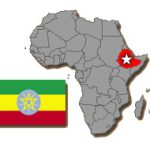Geography
The French West Indies consists of the four main islands of Martinique, Guadeloupe, St. Martin (the French half) and St. Barthelemy. These islands are well organized as tourist destinations with French spoken as the official language, although English is widely spoken in St. Martin and St. Barthelemy (perhaps because they are closer to the English-speaking Virgin Islands). The four islands (and their smaller satellite islets) are territorial overseas departments of France and as such are part of the EU and use euros as their currency; US dollars are also widely accepted.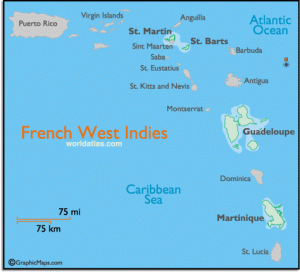
Guadeloupe includes the smaller islands of Marie-Galante, La Desirade, and the Iles des Saintes. The land area of this group totals 1,628 sq km (629 sq mi). (For comparison, New York City is 304 sq mi.) It is a pretty island but has been hit by half a dozen severe hurricanes in the past century. The poetry of resident Saint-John Perse won the 1960 Nobel Prize in Literature.
Martinique has a land area of 1,128 km2 (436 sq mi). Guadeloupe and Martinique are often thought of as a unity but they are actually about 150 miles apart (between capital cities). (In between these two is the island nation (former UK) of Dominica (290 sq mi; 750 sq km) which today criminalizes homosexuality). Martinique’s dramatic history includes a volcanic eruption in 1902 that destroyed the town of Saint-Pierre and left 28,000 dead within minutes.
Scenic St. Barthelemy (also called St. Barts) is tiny with only 8.5 sq mi (22.1 sq km). It is an attractive and expensive destination favored by the ‘rich and famous’. The nearby larger island of St. Martin (87 sq km; 33.5 sq mi) is divided (since 1648) in about half between the Dutch territory of Sint Maartin (34 sq km; 13 sq mi) and the French territory of Saint Martin (53 sq km; 21 sq mi)–both within the French West Indies. French Saint Martin has the same political status as Martinique, Guadeloupe and St Barts–territorial overseas departments of France. Oddly, on both halves of St Martin island English is the dominant language with a local dialect spoken informally. The island is a very popular vacation destination with an average of 1,000,000 tourists arriving each year, mostly from Europe.
St Martin and St Barts are located another 150 miles north of Guadeloupe in this alphabet soup of Caribbean nations and languages. That’s a stretch of about 300 miles between Martinique and St Martin, hardly a unified French territory.
Politics of Sexuality
What is unified is the politics of sexuality. France sets the standards and details of governance that includes the rights of gay people on their four islands. These rights are the same as on the French mainland. Homosexuality in Guadeloupe, Martinique, St Barts and St Martin has been legal since 1791. As citizens of France LGB couples here are eligible for a PAC (civil solidarity pact; a form of civil union between two adults (same-sex or opposite-sex) since 1999. It brings rights and responsibilities, but not full equality to marriage, at the moment. Fortunately the laws do forbid anti-gay discrimination.
However, the position of laws only effects legal procedures and generalized public behavior. More personally, there is ever-persistent disapproval of sexual lifestyles that don’t fit the standard man-woman stereotype. Many LGBT people hide their truth behind straight marriages, closeted second lives or moving abroad.
Gay Activist Group in the Antilles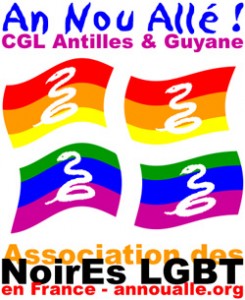
There is one LGBT activist group located in Guadeloupe and Martinique (and Guyane), ‘An Nou Allé‘, is the gay and lesbian association of the French Antilles. (The name of the group means “Let’s Go” in Creole.) “Since June 2004, this association has been vocal in protesting discrimination and injustice on the islands. Their website is in French, of course, but the text can be translated via Google Translate.
Beauty and Leisure on Guadeloupe and Martinique
Although individual opinions of residents and tourists vary, there is no dispute about the overall lush tropical flora, pleasant climate, beautiful white sand beaches (some nude, some gay), crystal blue waters and friendly people. As mentioned, France legalized homosexuality in 1791 and the current age of sexual consent is 15 for all. These two islands have a modest LGBT scene of gay bars, discos, saunas, gay beaches and a gay organizations. But if a visitor is looking for a party sort of holiday, somewhere else is probably better–Puerto Rico, Curacao, St Croix. As one blogger said, “if you’re in the mood for gorgeous scenery, amazing beaches, delicious food and rum, awesome hikes in the mountains, then the French Caribbean is the way to go.”
Guadeloupe
This island (total population about 406,000; 629 sq mi) is geographically bigger than Martinique with more to do especially in Basse-Terre capital and second largest city; population about 15,000) and in Point-a-Pitre (the largest city with about 20,000 population).
Another gay tourist said, “in Guadeloupe everyone seemed very friendly and if anyone had any problem with us being gay, they certainly kept it to themselves. I don’t imagine you’ll have many problems as attitudes there seemed very French, very ‘Your business is yours, mine is mine.’ I don’t recall getting nasty looks or poor service (at least none that seemed related to us being a male couple). The nude beaches of Anse Tarare and Anse Saline in Guadeloupe are frequented by both gay tourists and local gays. However, the French gay magazine Tetu, warns gays on the islands to “increasingly take the precaution of coming to the beaches in groups and leaving before sundown.” Paradise has its limits.
A gay couple from Canada wrote, “we agreed that Guadeloupe was the best vacation we’ve ever had (we’ve both traveled extensively all over the world). We loved Guadeloupe so much we’re now planning our own trip to explore Martinique.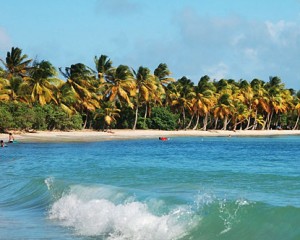 Some Martinique & Guadeloupe clubs.
Some Martinique & Guadeloupe clubs.
Martinique (436 sq.mi.) is more colorful and greener, some say. Although one visitor found some ‘attitude’ problems in Martinique (reported by a gay male tourist; not a surprise since the native culture is conservative and Catholic). He found it to be to a lesser degree than in Guadeloupe. He agreed the main attractions of both islands are the scenery and beaches. “They are both low key compared to some of the other islands. Do not expect big luxurious all inclusive resorts like St Lucia. The French, who make up the vast majority of the tourists, do not generally want that. French is the language in both islands, and although some English is spoken in tourist areas, do not automatically expect English to be spoken everywhere.”
Despite a sizable population of 414,000 (entire island) Martinique has only a modest but friendly gay scene that in recent years has been improving but nonetheless remains conservative. Martinique makes a good destination if you want somewhere quiet with a ‘light’ gay life. A visitor reported there is one gay club, one gay beach (Les Salines) and two mixed bars. Also see this site. Generally, the atmosphere here for the gay traveler is warm and it’s easy to find LGB venues. There’s much to see and do on land and in the water and in the towns. If a party happens (for tourists) it will be at ‘happy hour’ and in evenings.
The capital of Martinique is Fort-de-France . With a population of over 93,000 this large city is where a visitor will find Martinique’s modest offering of bars, gay, straight and mixed. Said one happy traveler, “there is a distinct Parisian feel here in this city, with a reminiscent European flavor, against the backdrop of the Caribbean. Here is found French fashions, French foods and cultural artifacts such as art and sculptures and the usual artisan and souvenir shops. Inland are the delights of nature, lush rain forests abundant bird life and hiking.”
Martinique mounts an annual Carnival where gay, straight and in between locals and guests are indistinguishable in their revelries and flourishing outfits.
One lesbian visitor wrote, “laid back and relaxed is the overall atmosphere in Martinique which is what makes it an ideal locale for the gay traveler. Whether you are shopping in its fine boutiques, trekking through the rainforest, unwinding on the beach, or partying in the bars, you will be sure to have a great experience.” More typical of local gay Caribbeaners is gathering at homes for private parties. “Local Antilles people function by clans and affinity groups form and organize evenings with each other. Word-of-mouth reveals the place and time…” http://martiniquegaybars.com/page/about
Scene and Scenery in Pro-gay St Martin and St Barts (for expats and visitors)
St Martin
St Martin has become a popular international destination in part due to its diversity: It is home to dozens of different nationalities as well as varying lifestyles, creating an open-minded spirit. Plus there are 32 beaches to choose from, quiet and secluded to vibrant and partying, from walking to nude sunbathing, there is a beach for everyone–including a gay beach–where snorkeling and scuba diving are popular. One diving facility is even a member of IGLTA.
In the towns there is a multitude of craft workshops and art galleries where both local and international artists display their work. Nightlife offers laid back outdoor lounges and wild music/dance night clubs as well as busy casinos. The shops of Marigot, the capitol and largest town of French St Martin (population about 6,000), features luxury boutiques and bargain souvenir stalls with everything in between. (On the Dutch side, easily accessible, the tiny capital of Philipsburg (population about 2000) has a front street with nearly one hundred boutiques–perfumes, electronics, liquors, fashion–that attract cruise ships passengers.)
Gay life in St Martin
Overall the gay scene is somewhat discreet and quiet with some busy nights especially on weekends. It offers a gay beach and a nude beach–for all, in front of Club Orient Resort. There are gay guesthouses, art galleries, clubs and bars. Its cosmopolitan feel has attracted many American and European gays to buy primary or secondary residencies there. Some gay venues.
One LGBT venue is Eros Club which describes itself as “small, discreet, easy going gay bar and club for both tourists and locals; some wild parties and great fun happen here such as Chippendale style dancers, drag queens, go go boys, male lingerie shows, etc).”
As always with entertainment venues, the circumstances, owners and popularity of any one place can change within one season. The places mentioned here are researched from the Internet and cannot be guaranteed as accurate. Things are not always as they appear online. This comment was posted by a visitor disappointed with his visit to Eros Club: “We hit this place twice on a Saturday night (the only night it’s open) and there was never more than a dozen people there. That would be ok…. However the bartender was very snooty and not friendly. The drinks were very overpriced as well! This part of the island (Margiot, (on the French side) 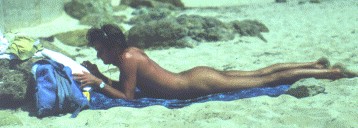 was desolate and mostly closed up despite being a weekend night. So we went over to the Dutch side and ran into plenty of gay guys! ”
was desolate and mostly closed up despite being a weekend night. So we went over to the Dutch side and ran into plenty of gay guys! ”
(There’s not much gay night life in Dutch St. Maarten but sun worshipers flock to Cupecoy Beach, one of the Caribbean’s favorite gay retreats. Cupecoy is the gay beach, often populated with nude, toned bodies. There are three white beaches with surrounding caves, rock formations, and cliffs. Designer clothing and hair styling are optional toward the north end of the beach.)
St Barthelemy (St Barts)
St. Barts is known as a glamorous stomping ground for the higher end travelers. Its has scenic beaches and haute cuisine fit for ‘superstars’–and the rest of us if we choose. The downside to St. Barts is that it’s subject to catastrophic cyclonic storms. The chic island’s coastline is too rocky for cruise ships to dock but private yachts are able berth here.
The most fun way to get around the island is by 4×4 vehicles as the roads are often steep and windy. It’s small enough (eight-square-miles) that one can drive around it in thirty-minute drive but the sightseeing experience will slow the drive. Because of its exclusivity–expensive–and high-end demographic, St. Barth is one of the safest islands in the Caribbean. Petty theft is about the only concern, but that’s everywhere.
This island has been called the most gay-friendly island in the Caribbean, perhaps because there is no separate gay scene, gay bars or gay clubs. LGBT visitors simply mix in with the generally sophisticated well-heeled crowds at public places. There are openly gay staff and owners in the trendy restaurants and swanky clubs as well as other venues of the island’s tourist industry–diving, transportation, catering, fashion and styling shops. One observer said, “in contrast to other Caribbean islands where homosexuality remains illegal, and even where ‘tolerated’ gay visitors are sometimes frowned upon by conservative locals, St Barts is easy going and no one is concerned with anyone’s sexuality.”
Other comments about St Barts
“St Barths is great. Very gay friendly and good food and wine but it’s expensive and it’s not a gay party island by any means (but you shouldn’t go to the Caribbean if you’re looking for Ibiza style gay nightlife).”
“A gay friend of mine found a good scene down there, more refined. He tends to stay exclusively at villas nowadays but did enjoy Francois Plantation for a time. He said that Saline beach was a popular pick-up spot during the day; there’s more ‘activity’ at the secluded area.”
“Overall, stunning island and it will spoil you against any other Caribbean destination. Once you get over the sticker shock, it becomes more enjoyable. Remember, you’re paying for safety and exclusivity.”
“As far as gay nightlife, there isn’t any. But just like Paris or any other sophisticated destination, it’s totally gay friendly. Basically, it is quite couple-oriented, not with a late night scene.”
“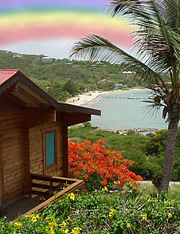 My partner and I have vacationed in St. Barts before, and there really isn’t a “gay bar” or anything of the sort on the island. That said, there is absolutely no need for one. You will find St. Barts to be easily as gay friendly as San Francisco, London or Paris. This is a culture that, fortunately, has remained untouched by the homophobia that has been spread by much of the “native” populations on other islands.”
My partner and I have vacationed in St. Barts before, and there really isn’t a “gay bar” or anything of the sort on the island. That said, there is absolutely no need for one. You will find St. Barts to be easily as gay friendly as San Francisco, London or Paris. This is a culture that, fortunately, has remained untouched by the homophobia that has been spread by much of the “native” populations on other islands.”
“Having visited every beach on the island numerous times, my personal pick is Governor’s Beach. I found it to be a great mix of beautiful sand, larger waves and great privacy. When we were last there in May, we had a good 100+ feet between us and the next person on the beach. All of the beaches seem gay friendly. On our recent trip, we ran into a nice gay couple from the Philly area that were frolicking around in the ocean 100% nude. No one on the beach so much as looked up — it wasn’t even an issue. Sexuality truly isn’t a problem here, and for the best reasons — no one cares.”
Finally, more recently, OutTraveler gay magazine had this to say: “Today, French law and a decidedly laissez-faire sense of openness governs the island, which dazzles with its sheer physical beauty, a slate of new sleek, discreet hotels, Michelin-worthy cuisine, Madison Avenue–level shopping, and a “don’t ask, don’t care” crowd.”
The Dark Side of Paradise
As with any place with many people, all is not pretty, happy and prosperous in the Antilles. In 2001 the French gay Magazine, Tetu, published an in-depth report about homosexuality in the French Antilles, including sex-workers and ‘down-low’ closeted men in Martinique. The following excerpts, quotes, descriptions and interview are taken from that report.
Many black, mixed and white young people hide their desires in the daytime and only emerge from the shadows of the night, some to meet friends for a drink and others to offer services to any local or tourist with money. “In Martinique especially, queers prefer to close their eyes to this phenomenon they do not want associated with homosexuality–male prostitutes working certain streets and parks and near the courthouse in central Fort-de-France.”
It was reported that workers in dra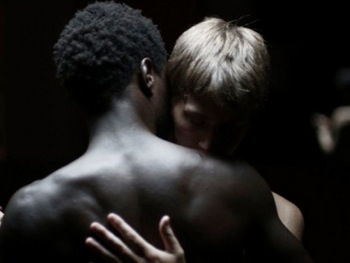 g present themselves along the pathways to the famous Saline Beach where nudity is tolerated, near the town of Sainte-Anne. The Tetu story said (translated from French), “…around the cape, called Catherine advanced, men wander among the mangroves, nonchalantly, staring by the corner of the eye. Gays frequent this place quite isolated every day of the week, but on weekends, they give more space for families who come to relax on the beach. Some men with wives and children, under the pretext of stretching their legs or going for a beer, make a detour through the bushes.”
g present themselves along the pathways to the famous Saline Beach where nudity is tolerated, near the town of Sainte-Anne. The Tetu story said (translated from French), “…around the cape, called Catherine advanced, men wander among the mangroves, nonchalantly, staring by the corner of the eye. Gays frequent this place quite isolated every day of the week, but on weekends, they give more space for families who come to relax on the beach. Some men with wives and children, under the pretext of stretching their legs or going for a beer, make a detour through the bushes.”
Fear of ‘Kite’
Tetu also described the fear and hiding of closeted gay men in Martinique: “In the evenings blacks, find it difficult to go clubbing without being seen by peers, whether in France or the Caribbean. Jerome, 41 years old, living in Martinique, sighed: ‘A friend from Paris knew exactly when I danced with this person.’ Pascal, a local man, said ‘the gossip is part of our culture. Every Caribbean is afraid to find himself the central subject of a kite.’ (Note: living the down-low happens for women as well.)
The kite is gossip, rumor, or anecdote that is feared. The Caribbean, the proverb “all milan brings a cancan” is easily verified. A man named Thierry said his mother feared the gossip about her son’s sexuality when he went on holiday together with another man. Caribbeaners constantly are on the lookout for a kite. In Martinique, he said, “I realize that the boys stare from cars without bothering to hide their eyes. It would be bad for me to show any kind of desire or attraction. We can’t forget that we are on a small island and more likely to meet people we’ve know. Sometimes they look at you, asking you if you have already been seen somewhere. Thierry’s friend Jerome advised, “you make a lot of friends when you know how to shut up.”
Interview With Gisele
Gisèle Pineau, a writer from Guadeloupe, discussed the attitudes of the Antilles Caribbean culture that “does not see us”. (Translated from French)
Question:
How is homosexuality perceived in the West Indies?
Answer:
“Taboo” is the word that comes to mind. Taboo. It hides the thing we do not want to see or believe. A man must be a straight man, a point, that’s all. A man loves a women, and has children. Whoever deviates and becomes a faulty makoume. (In Creole, the term for a fag is ‘makoume’.) Major insults are intolerable such as a “beautiful cock poser” who is an effeminate man. Many believe this “man-woman” has grown up with women: mothers, sisters, aunts, cousins, grandmother and has taken the ways of women, and has not seen his father. Caribbean fathers fear a son to become a ‘beautiful cock poser’. He wants him to be a man with manly sports, hardened attitudes, with tears prohibited. If homosexuality is 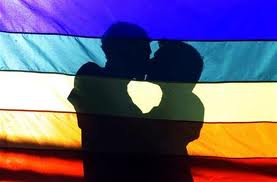 proven, the wound is terrible for the father. It’s better accepted by the mother.
proven, the wound is terrible for the father. It’s better accepted by the mother.
“There are dirty jokes about makoumes. When homosexuality is discussed publicly, people grimace, speak of defects, uncleanliness. Those gays who live in the West Indies are discreet and live in small closed circles. Many choose exile or the anonymity of large crowds (Fort-de-France) where they will not be recognized by their neighbors and can live according to their soul; or go to France, United States or England.
“Often it is difficult for Caribbean gays, living together as a couple. They must use subterfuge to avoid arousing the suspicions of neighbors. However, today there are more and more who talk openly about being gay and live in Guadeloupe or Martinique. Young homosexuals do not want to emigrate or hide like bandits… attitudes are changing slowly. More young gays who leave the Caribbean to join big cities are discovering the meaning of ‘visibility’. When they return to the West Indies, they no longer want to stay in the closet.”
Anyone interested in the condition and circumstance of LGBT people in the Caribbean should read the report issued by the International Lesbian and Gay Association in 2011.
It is a complete report that lists the gay-friendly as well as homophobic states in the Caribbean.
In the following nine countries homosexuality is criminalized:
Antigua and Barbuda,
Barbados,
Saint Vincent and the Grenadines,
Dominica,
Grenada,
Jamaica,
Saint Kitts and Nevis,
Saint Lucia,
Trinidad and Tobago.
Fortunately in the Caribbean there are more countries in which same-sex activity is legal (but not free of homophobia).
These are:
Bahamas,
Bermuda,
British Virgin Islands (Tortola, Virgin Gorda, Jost Van Dyke, Anegada), legal since 2000
Cayman Islands, since 2000
Cuba, since 1979
Dominican Republic,
Montserrat, since 2000
Netherlands Antilles (Aruba, Bonaire, Curacao, Sint Maarten, Saba, Sint Eustatius)
French West Indies (Antilles) (Guadeloupe, St Barths, Martinique, St Martin), since 1791
Haiti, since 1986
Puerto Rico,
Turks and Caicos Islands, since 2000
US Virgins Islands (St. Croix, St. John, St. Thomas, Water Island), since 1984
Also, see this LGBT report on eleven Caribbean destinations that includes some gay owned and gay-friendly venues:
Related links:
Book:
Perspectives on the Caribbean: A Reader in Culture, History, and Representation
Philip W. Scher, Kevin Yelvington
Ch 5: Homosex, Society and the State… Martinique
David AB Murray
———————
Doug Ireland commentary on Dutch and American Teen Sex
(book review of History of Homosexuality in Americas)
————————-
Worse Than The Closet: Murder
In 2006 there was a murder of a gay young man.
——————————
Le Jeu de Qui? (The Game of Who?)
Sexual Politics at Play in the French Caribbean*; research article (pdf) (translation)
———————————-
Chronicles of a Negro Invert;
Guadeloupe, Martinique, French Guiana: gays, lesbians and bi show up.
————————–
The Indian Ocean island of Réunion, another French overseas department, has signed on to a “Gay-Friendly Charter of Conduct” and actively seeks the gay tourist trade by participating in the annual French gay business expo, ‘Rainbow Attitude’.


